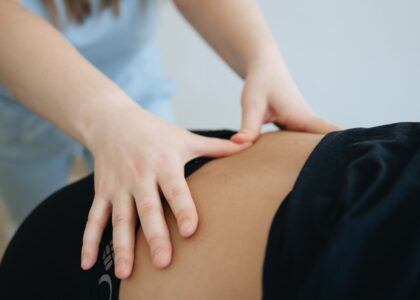Years of couch potatoes, office work, and cell phone holding habits can lead to chronic pain and musculoskeletal pain due to poor posture habits formed. Posture correction is a preventive measure against future health issues through the reconstruction of the natural body structure and posture. The adequate placement of the spine reduces the pressure on the muscles, joints, and ligaments, therefore, avoiding further degeneration, and realising the long-term effect of eliminating pain. Professional advice being necessary in some instances, an Osteopath Dover Kent may offer customised consultations and treatment plans in postural distortion correction. Early correction of postural deformities not only alleviates current pain but also guards against degenerative disease in the future. This article investigates eight major advantages of posture correction for long-lasting pain alleviation and enhanced wellness.
Lessen Spinal Compression
Up to 30% more vertical pressure on spinal discs results from bad posture, thereby speeding degenerative changes. Correct alignment evenly distributes weight throughout vertebral structures, averting early disc wear. Slouching posture makes the spine have unnatural curves thus making it create compression points leading to chronic back pain. Proper posture maintains the natural curve of the spine, so that the discs can comfortably cushion the jolt. Osteopathic procedures aid in decompressing afflicted areas while teaching patients alignment techniques. Over time, decreased compression in spinal joints and adjacent soft tissues reduces inflammation. This preventative strategy has proven to be more successful than treating current disc damage later.
Relieves Neck and Shoulder Tension
Common with phone or computer use, forward head posture adds up to 12kg of stress on neck muscles. Proper alignment brings the ears directly over the shoulders, eliminating constant muscular effort to support the head. Instead of hunchunchingforwardhoulders naturally relax down, whi,, ch helps lower the trapezius muscle overuse. Postural retraining reduces tension headaches originating from suboccipital muscle strain. Patients sometimes say that within weeks of beginning therapy for tech neck, their symptoms have significantly lessened. Regular breaks, together with awareness of alignment,nt help to stop recurring stiffness.
Enhancing Breathing Efficiency
Correct rib cage alignment improves respiratory muscle function, therefore helping both asthma sufferers and vocal professionals. Postural correction helps COPD patients maximise remaining lung function through better mechanics. Many claim to be immediately calmer when assuming correct alignment since posture and breathing are related. Instant changes come from basic changes like sitting forward on chair seats with feet flat.
Helps to Stop Degenerating Joints
Misaligned posture leads to unbalanced joint loading and asymmetric cartilage breakdown. Correct alignment evenly distributes forces across joint surfaces, therefore slowing osteoarthritis development. Leg length differences or pelvic tilts cause hip imbalances that speed up labral tears. Muscle balancing exercises and proprioceptive training are among corrective techniques. Often, knee pain goes away when posture adjustment fixes underlying foot pronation or hip weaknesses. Even hand/wrist issues are connected to incorrect shoulder positioning during desk work. Rather than only addressing symptomatic regions, osteopathic assessment finds these kinetic chain connections for whole-body solutions.
Enhances Digestive Performance
Proper seated posture keeps room for optimum digestive organ positioning and peristalsis. Postural correction lowers intraabdominal pressure, thereby helping hiatus hernia symptoms. Walking with an erect posture enhances bowel motility through natural torso rotation. Even chewing mechanics improve when head position aligns properly over the spine. Patients frequently say that steady postural retraining lowers bloating and enhances digestion. Basic changes like raising computer displays to eye level stop the midday slump that results after meals taken by several office employees.
Raises Energy Levels
Bad posture calls for 20% more energy expenditure to maintain against gravity. Correct alignment saves muscular effort by allowing bones to function effectively. Removing vascular compression sites improves circulation by using proper posture. Improved oxygenation resulting from better breathing adds still more vibrancy. Maintaining good desk posture helps many people avoid afternoon exhaustion. Confident neurochemicals are released psychologically from an upright posture. Patients claim that after the afternoon postural awareness, they sleep better and need less coffee. For people with chronic exhaustion disorders, energy conservation turns especially helpful.
Stops Developing Chronic Pain
Early postural correction stops the accumulating damage, resulting in irreversible changes. Youthful flexibility sometimes hides developing postural problems till middle age. Long-term rewards come from proactive effort,,s including postural workouts and ergonomic evaluations. Correct alignment during smartphone use stops text neck degeneration. Standing workstation position impacts future hip and knee conditions. Even sleeping posture adds to postural patterns requiring daytime correction. Regular osteopathic exams catch subtle imbalances before they become painful. The Osteopath Dover approach emphasises prevention using knowledge and early intervention.
Conclusion
Posture correction offers a strong, noninvasive cure for both present pain and future pain avoidance. Through whole-person alignment, pain relief and enhanced organ function occur with continuous use, turning corrective exercises into healthy habits of posture that become second nature. Professional instruction ensures individually adjusted solutions with concerns regarding personal habits of life and anatomy. An investment in posture now prevents costly treatments for long-term pain later and constitutes overall well-being. Whether it is accomplished through self-study or professional instruction, good posture is one of the most effective long-term answers to comfort and musculoskeletal health.



